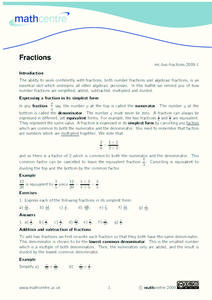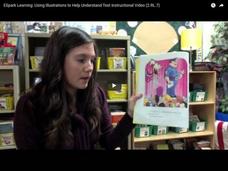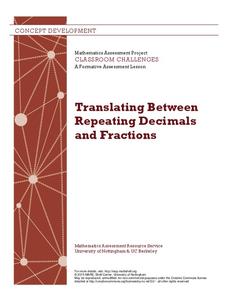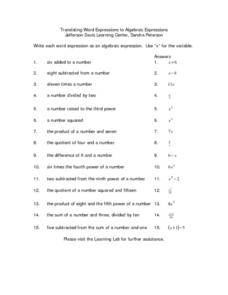Curated OER
Logarithmic Forms
There are 10 different problems related to particular logarithmic forms for learners to solve. They express each exponential form equation given in logarithmic form and write out the opposite of each form as illustrated.
Math Centre UK
Fractions
Reinforce fraction instruction with an informative worksheet equipped to provide independent practice, as well as guidance and modeling. Support is provided to boost proficiency in finding equivalent fractions, and adding,...
Balanced Assessment
Local and Global Behavior
Create rules for numerical sequences. Pupils develop local rules and recursive rules for number sequences. The sequences are linear, quadratic, and cubic in nature. Scholars find that some local rules do not work, no matter where in...
Math Mammoth
Word Problems
Upper grade and middle school learners problem solve and calculate the answers to twenty various word problems involving multiplication, and a bar graph.
Balanced Assessment
Vacation in Bramilia
This performance task gives the population model of different types of flies and asks scholars to analyze the two populations. After interpreting the functions individually, participants compare the two populations and find the time...
Mathematics Assessment Project
Representing Quadratic Functions Graphically
Sometimes being different is an advantage. An engaging activity has scholars match cards with quadratic functions in various forms. Along the way, they learn about how each form highlights key features of quadratic functions.
Illustrative Mathematics
Fruit Salad
Playing with values in this fruit salad problem allows learners to find out how many cherries were mixed in. Your middle schoolers can organize their thoughts in a chart before going into the equation. Eigth graders can skip the chart...
Software Smoothie
Imagination Box - Colors, Shapes, Numbers and Letters
This app provides young learners with opportunities to be creative while they work with different colors, letters, numbers, and shapes.
Illustrative Mathematics
Temperature Conversions
Complete two conversions at once using compositions. Pupils use the conversion formulas for temperatures to calculate a formula to convert directly between Kelvin and Fahrenheit. Classmates determine the meanings of composition...
Education Development Center
Making Sense of Unusual Results
Collaboration is the key for this equation-solving lesson. Learners solve a multi-step linear equation that requires using the distributive property. Within collaborative groups, scholars discuss multiple methods and troubleshoot mistakes.
EngageNY
Systems of Equations
What do you get when you cross a circle and a line? One, two, or maybe no solutions! Teach learners to find solutions of quadratic and linear systems. Connect the visual representation of the graph to the abstract algebraic methods.
EngageNY
Solving Logarithmic Equations
Of course you're going to be solving an equation—it's algebra class after all. The 14th installment of a 35-part module first has pupils converting logarithmic equations into equivalent exponential equations. The conversion allows for...
Mathematics Assessment Project
Translating Between Repeating Decimals and Fractions
Model for your young mathematicians the process for converting repeating decimals to fractions. To demonstrate their understanding of the process, class members then complete and assessment task and participate in an activity matching...
Arizona Department of Education
Introduction to Integers
Welcome to the backward world of negative numbers. This introductory lesson teaches young mathematicians that negative numbers are simply the opposite of positive numbers as they use number lines to plot and compare...
Mathed Up!
Negative Numbers
Eight independent worksheet pages challenge scholars to solve 12 problems that focus on negative numbers in the context of temperature in degrees of celsius.
Education Development Center
Interpreting Statistical Measures—Class Scores
Explore the effect of outliers through an analysis of mean, median, and standard deviation. Your classes examine and compare these measures for two groups. They must make sense of a group that has a higher mean but lower median compared...
Education Development Center
Adding Fractions with Unlike Denominators
If the fractions don't have a common denominator, make them have one. Learners first read and analyze a conversation of pupils trying to add 2/5 and 1/2. They compare the process of adding fractions to the process of adding quantities...
Curated OER
Chapter 12 - Objective 2.1 Logarithm Form
In this logarithm worksheets, write expressions in expanded form, exponential form and logarithmic form. They evaluate and solve logarithms. This one-page worksheet contains ten problems.
Curated OER
Ratio and Proportion: Write and Interpret
For this ratio and proportion worksheet, students explore example problems. Afterwards, they read story problems and use ratios and proportions to find the solution. This three-page worksheet contains six multi-step problems,
Curated OER
Translating Expressions
For this Algebra I worksheet, 9th graders translate English phrases and sentences into algebra phrases and equations. The one page interactive worksheet contains a combination of thirty-five multiple choice and free response...
Curated OER
Translating Word Expressions to Algebraic Expressions
In this translating worksheet, students read a word sentence, and then translate it to an algebraic equation. Fifteen problems are provided on this one-page worksheet. Answers are provided on the right-side of the page.
Curated OER
Algebra Applies to the Real World? No Way!
Sixth graders examine the connections between math and real life. In this algebra lesson, 6th graders use Algepairs Cards to complete the problems presented and discuss how algebra relates the real world.
Curated OER
Pizza Topping Combinations
Students brainstorm pizza toppings and determine the number of possible ways to order a pizza. In this algebra lesson, students analyze and investigate geometric patterns as they relate to the concept of a variable. Students then...
Curated OER
Order of Operations
Seventh graders create a mnemonic device which correctly represents the order of operations. They simplify expressions by correctly following the order of operations. Students present their mnemonic device for the order of operations.























